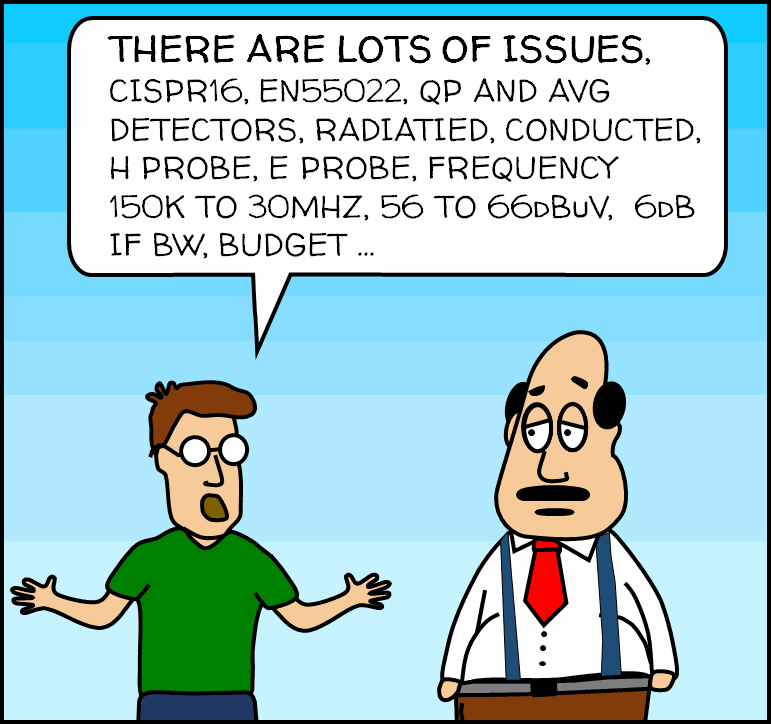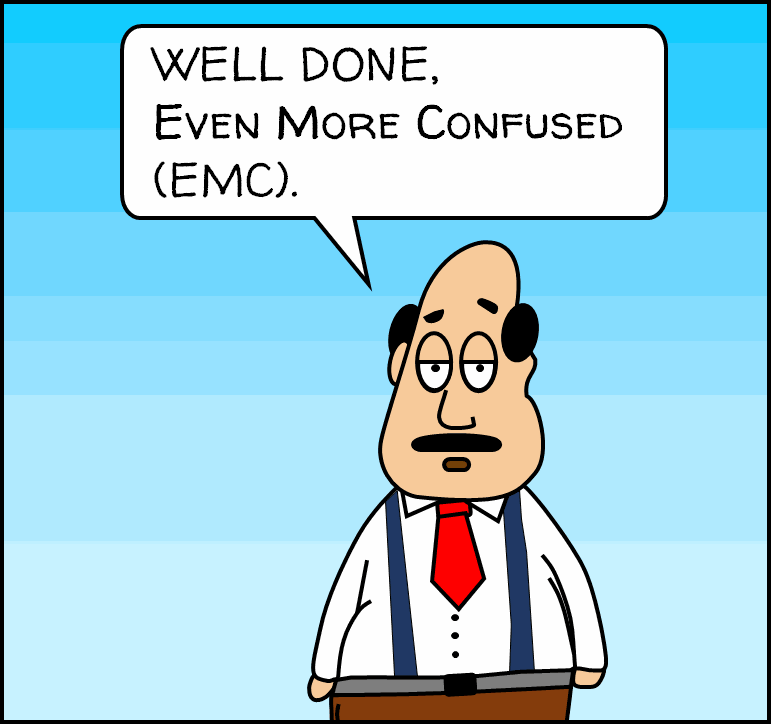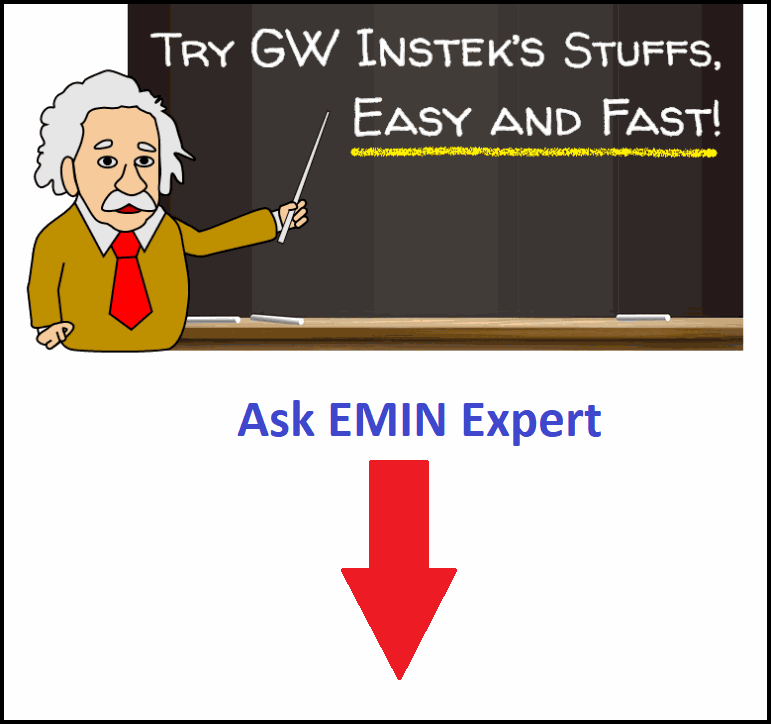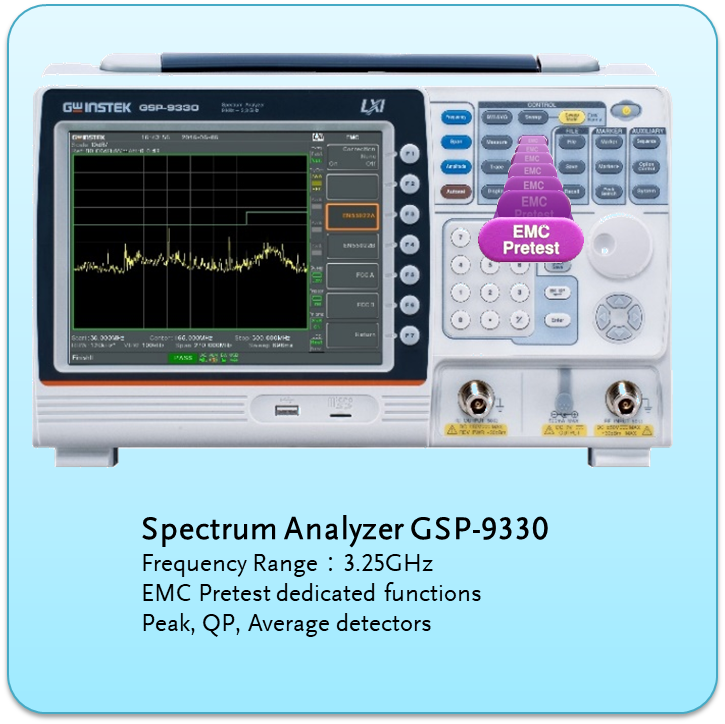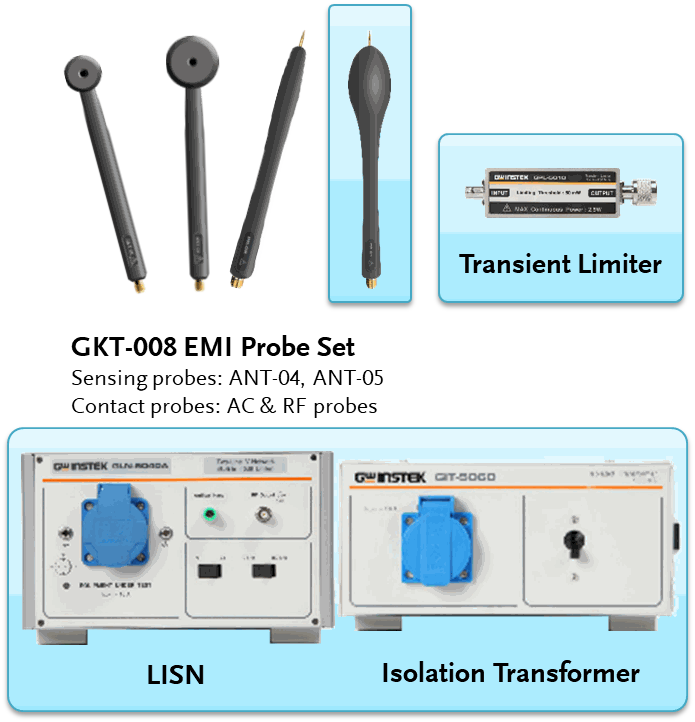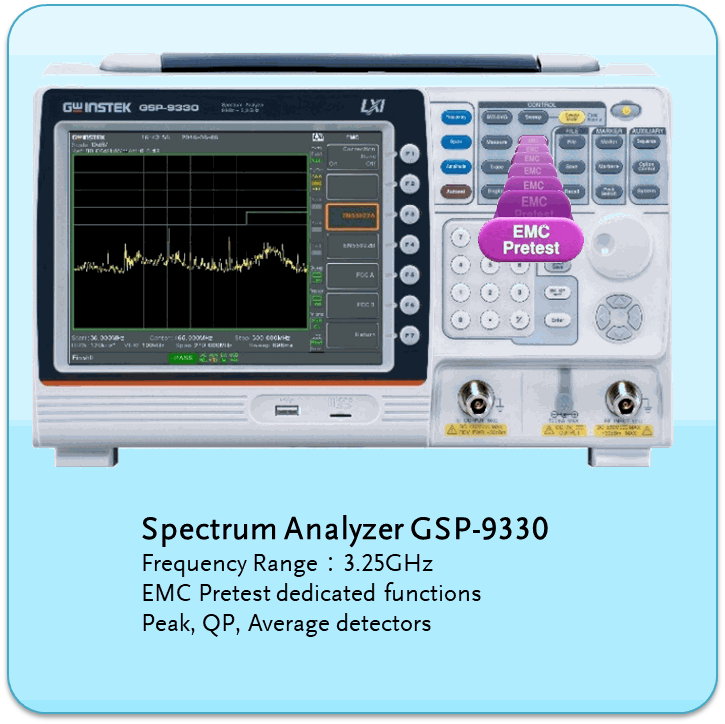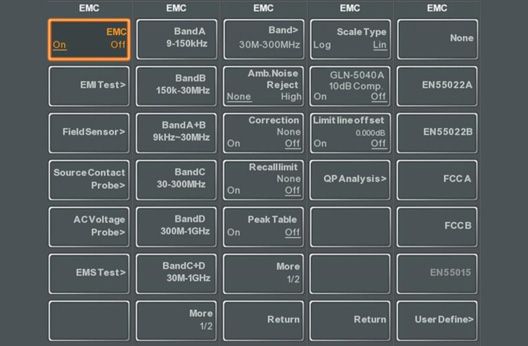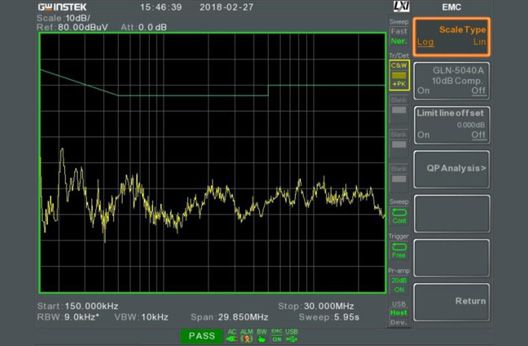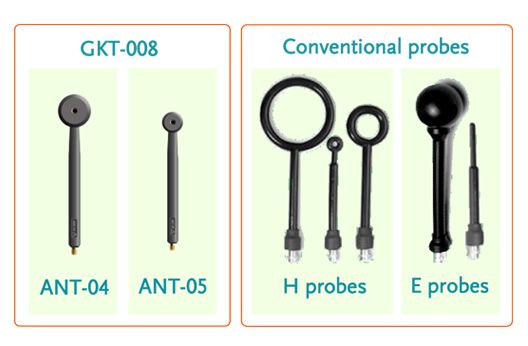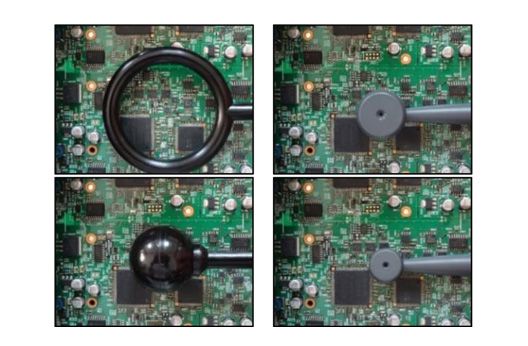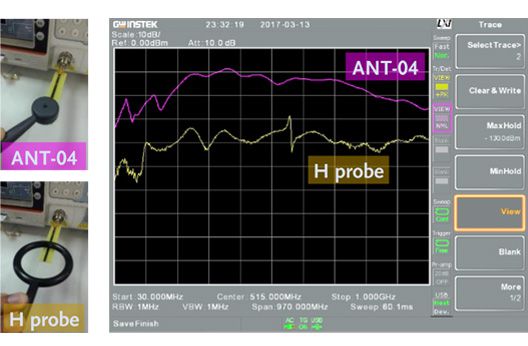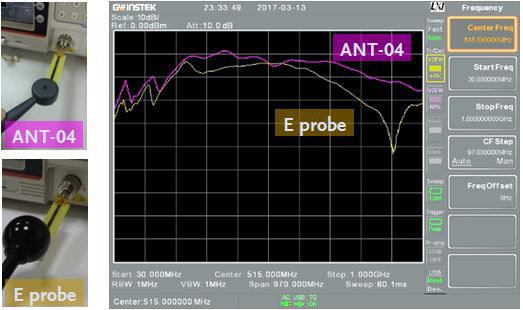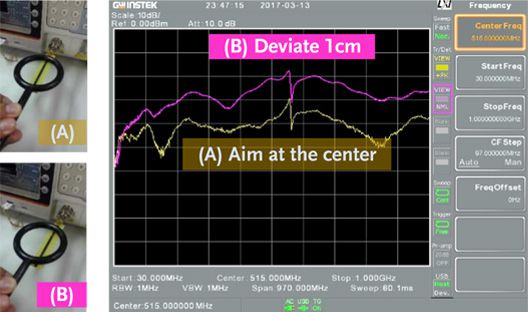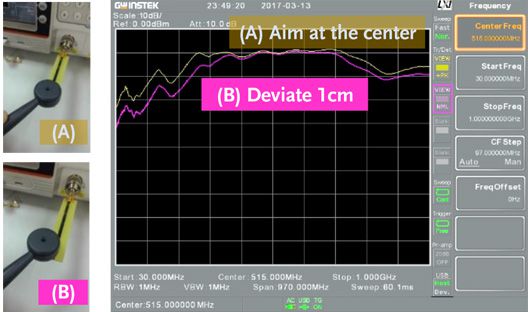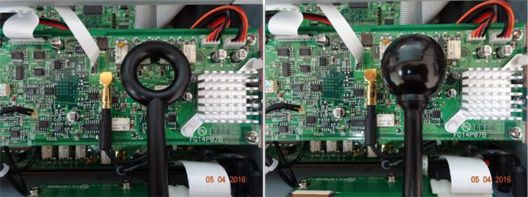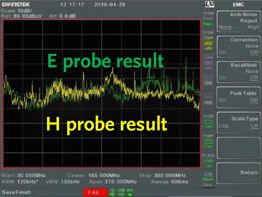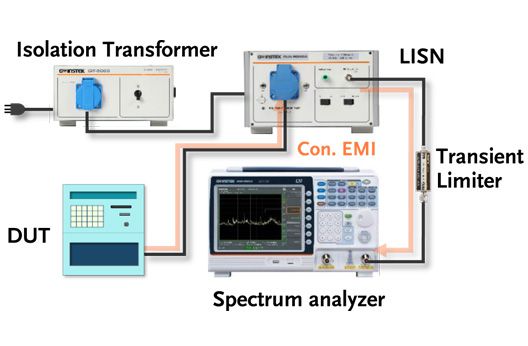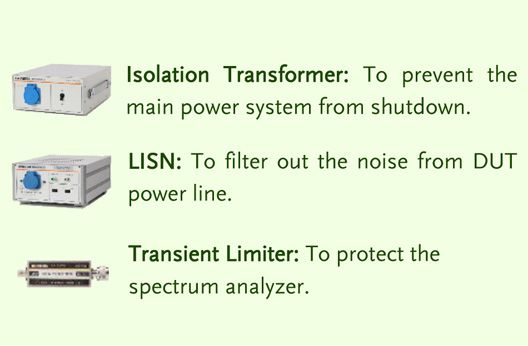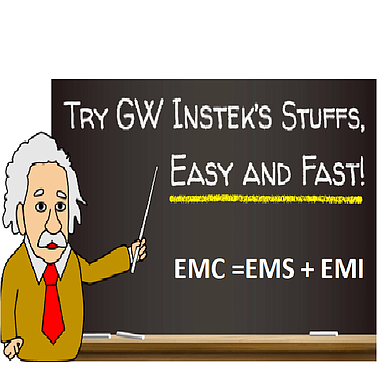
EMC AND EMI Pretest/Pre-compliance Solution of GW INSTEK
Manufacturer: GW INSTEK Model: EMC Origin: Taiwan Guarantee: 12 Month - Contact
Call for the best price
Hanoi city: (024) 35.381.269
Danang city: (023) 63.747.711
Bac Ninh city: (0222)730.39.68
HCM city: (028) 38.119.636
|
| EMI Pre-compliance Solution Detai |
Solution for Radiated EMI |
|
|
| The EMC Type and Path |
* EMC =EMS + EMI |
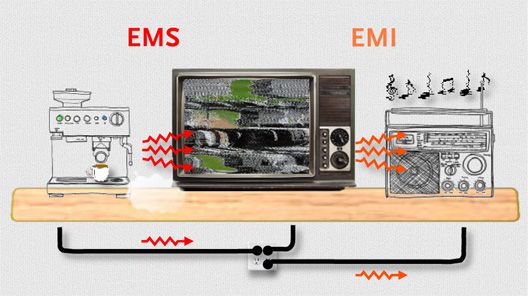
*Radiation via air & Conduction via power
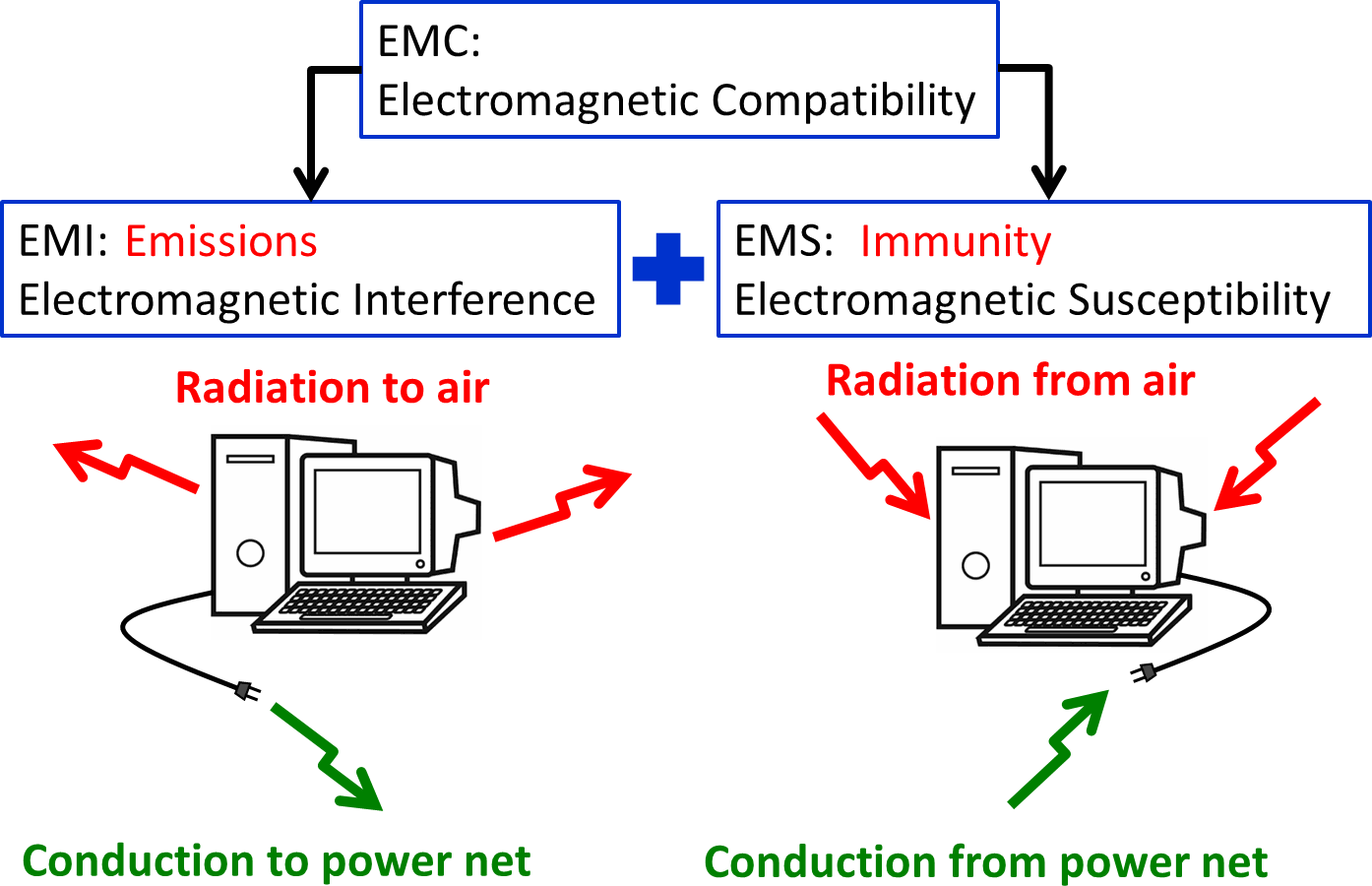
| GSP-9330 EMC Pretest Dedicated Functions |
Built-in EMI test standards |
|
|
Log scale frequency axis and peak table |
| Key features of GKT-008 |
| 1. Small size, high sensitivity |
GKT-008 vs conventional probes Identify EMI source better by small size
|
ANT-04: higher sensitivity than H probe ANT-04: higher sensitivity than E probe
|
| 2. No directivity issues for ANT-04, ANT-05 |
H probe: Different results with different angles ANT-04: Similar results with different angles
|
Working principle of conventional H probe (I)
H probe detects much more while deviating 1cm ANT-04 detects more while aiming the center
|
Why H probe aiming at center detects less signal?

| 3. Detecting separate H field and E field vs Sensing EMI energy |
H probe’s results differ from E probe
|
H field & E field are two components of EMI

ANT-04 and 05 directly sense EMI energy

| GSP-9330 built-in GKT-008 associated functions |
Far field response estimation

● Convert the near field measurement results to far field response (3m or 10m can be selected).
● Helpful to confirm whether the EMI trimming works or not.
| Conducted EMI Test Solutions |
Test system configuration
|
|
| GSP-9330 Auxiliary Functions |
Peak Table: Automatically search 10 peaks
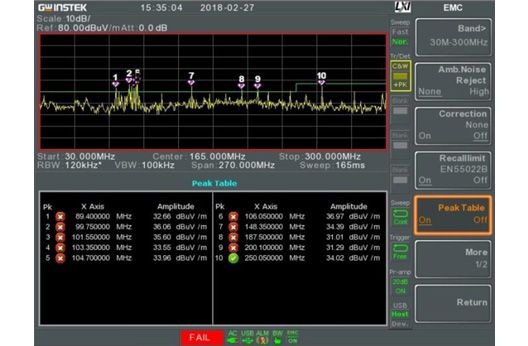
Pass/Fail: Inspection result display
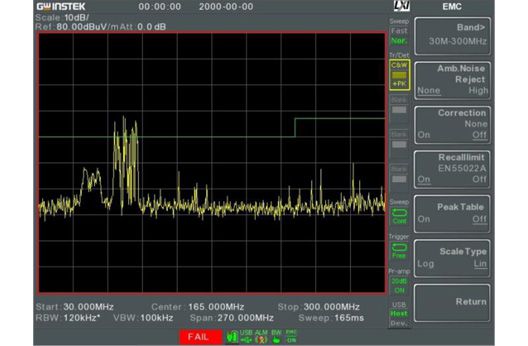
* Một số Video hường dẫn Kỹ thuật cơ bản về kiểm tra EMC của hãng GWINSTEK:
1> General introduction of GW Instek EMC pretest solution (3:04)
Briefly explain EMC basics, and introduce GW Instek's EMC pretest solution and its advantages comparing with conventional EMC test products.
2> EMC, EMI and EMS basics . Radiated and Conducted. (1:43)
EMC includes EMI and EMS. EMI is the self-emitted noise poses impact on other electronic devices, and EMS is affecting electronics products by surrounding electronic devices' noise.
3> Challenges of using conventional H probes and E probes. (1:55)
Use H probe with different angle will get different magnetic field measurement result, electric filed measured by E probe is also different from H probe.
4> Peak, Average and QP(Quasi-Peak) detectors. (1:54)
In order to accurately measure different type EMI signals, the regulations require using Peak, QP and Average detectors to conduct measurements to determine if the results meet the regulations.
5>High efficiency EMI debugging probes (2:57)(1:43)
See how the GKT-008 sensor probe set provide the unique to make the EMI debugging easier and faster.
6> Application example of sensor probe and explain how it works. (2:50)
The conventional electric field and magnetic field probe have a larger difference on the measurement results. But for GKT-008, it can find the identical signals found in the lab.
7> Conducted EMI test solution. (1:29)
GSP-9330 spectrum analyzer collocating with LISN GLN-5040A and an isolated transformer GLN-5060 can conduct conductive EMI.
8> Only 3 pushing-buttons start GSP-9330 EMC pretest (1:31)
A demo video shows how to start EMC pretest by simply 3 pushing buttons on GSP-9330. (a temporary link needed to be reloaded into gwinstek1975 account)
9> With the GSP-9330, You Only Need To Focus On EMI Measurements. (1:09)
LET ENGINEERS DO WHAT THEY ARE SUPPOSED TO DO!!!
It often takes a lot of time to understand the operation and settings of the instrument when conducting the EMI test. Furthermore, most engineers are interrupted and asked to solve the EMI issues.
*** Các tài liệu về Giải pháp kiểm tra EMC của hãng GWInstek:
| EMC Documents and Resources | |
Application Note - The brand new concept of EMI probes Simplify the complicated EMC measurement and debugging! | |
Brochure of General introduction of EMC pretest solution | |
Slide of General introduction of EMC pretest solution | |
*** Các câu hỏi thường gặp về giải pháp kiểm tra EMC của hãng GWInstek:
GW Instek's EMC pre-compliance solution focuses on enabling engineers to quickly and easily evaluate and debug product’s EMI in a general working environment. The differences of certified laboratories which focus on certification are as follows:
| ||||||||||||||||||||||
02. What should I do if there is a difference between the Pre-compliance and the certified lab test results?It is normal for the pre-compliance and certified lab test results to be different, so it is important to understand the cause of the difference in order to get a reference from the pre-compliance measurement so as to conduct debugging. The difference between the two can be referred to “What is the difference between the Pre-compliance test and the program used by the certified laboratory?”. The most important thing is to establish a test reference for pre-compliance after obtaining the differences between the two. For example, pre-compliance test needs to be tightened and reduced a certain standard (such as 4dB reduction) under regulatory standards that is a margin for testing by certified laboratories. After accumulating and establishing such a test reference, the successful measurement rate in the certification laboratory will be greatly improved. | ||||||||||||||||||||||
The environmental noise includes conduction and radiation EMI. After connecting the DUT, the EMI measurement is performed before the power of the DUT is turned on. The result obtained is the environmental noise, and then the power of the DUT is turned on to distinguish between ambient noise and DUT EMI signals. 1. Use Trace comparison mode Users can compare the difference via the measured Trace under different states to determine whether the noise is caused by background noise or the DUT by analyzing the waveforms. In the following example, users can connect the GSP-9330 with the near field probe or LISN before the DUT is turned on; then set the Trace in the sweep to the View mode. The Trace obtained at this time will be background noise, which is the yellow trace in the following picture. Turn on the power of the DUT and enter the operation mode. At this time, another Trace is used for testing. Now you can see the difference of the signal, such as the pink Trace. The comparison method is used to confirm whether the signal found is from the DUT. As shown in the following display, the signal in the red frame shows that the signals measured before and after the DUT is turned on are almost similar, which means that the signals in this frequency bandwidth are more likely the background noise. Users can eliminate the issue when analyzing.
2. Use Topographic display mode Another mode is to use the Topographic display mode. (This mode cannot be used under the EMI Mode. This mode can be used after leaving the EMI Mode)
| ||||||||||||||||||||||
In the EMI test, to determine whether the DUT can pass the EMI regulations, the signal must be detected by the detection method of QP Detector and EMI-Avg Detector respectively. When testing by an EMI receiver in a laboratory, in order to speed up the test, the entire signal is usually extracted via PK+ Detection, and the signal frequency exceeding the limit regulation is captured, and then the narrow frequency or zero frequency is used to find out the QP and AVG values that exceed regulations. As shown in the figure below, the values of QP and AVG obtained in the EMI Report are the results obtained by the software in the background calculation and processing.
The EMI signal detection using the GSP-9330 focuses on the source of possible EMI during the Pre-Compliance phase and the Debug process, so PK+ Detector is usually used at this stage to find all EMI sources and identify larger sources of signals to analyze. If you want to know the value of QP and AVG at the frequency point found by PK+, manually set the Span to narrow or zero frequency and set the detection mode to QP or AVG. | ||||||||||||||||||||||
There are three ways to generate EMI test reports for GSP-9330:
| ||||||||||||||||||||||
Yes. The GSP-9330 has built-in EN55022A, EN55022B, EN55015, FCCA and FCCB regulations. If other regulations are required, users can use the User Define function (as shown in the figure below) to edit and store the regulatory limit line on the spectrum analyzer. There is no limit to the storage capacity of the regulatory limit line, as long as the capacity is sufficient to store. However, if you need to call the test regulations, up to 5 sets of limit line regulations can be called at a time. In addition, you can use the dedicated PC software SpectrumShot for editing and remote control. The software can be downloaded freely from the GW Instek website. The software has built-in EN55011, EN55012, EN55014, EN55015, EN55022, EN55025, EN55032, FCCA and FCCB commonly used regulations. Users can select the items to be tested according to the test requirements, such as conduction and radiation, Class level, product category, Detector level etc., as shown below. If there are other regulatory requirements, users can also edit the new limit line. This PC software must collocate with the NI VISA driver. Please go to the NI website to download it.
| ||||||||||||||||||||||
07. GSP-9330 can display two Limit Lines of AVG and QP simultaneously in the conduction bandwidth setting of EMC Pretest Mode, but only one can be displayed when self-defining Limit Line. Can two limit lines be displayed?To display two self-defined Limit Lines, please use the GSP-9330 dedicated PC software SpectrumShot. This PC software must be collocated with the NI-VISA driver. Please download it from the NI website. | ||||||||||||||||||||||
When the EMI signal is too strong, the GSP-9330 will send a warning message to avoid damage to the spectrum analyzer. It is recommended to connect an attenuator before the input terminal. Power Over Range is determined by whether the signal is greater than Ref. Level. For example, the Ref Level in the figure below is set to 80dBuV, which means that Power Over Range will appear if the signal is greater than 80dBuV.  | ||||||||||||||||||||||
Yes, at this time, the RBW will switch to the EMI bandwidth according to the current frequency bandwidth.
After setting, each Trace will simultaneously scan PK+, QP, and AVG according to the settings. | ||||||||||||||||||||||
10. What is the difference between the GSP-9330 EMI Test > Correction > Horizontal/Vertical setting and Sensor Probe > Correction > 3m/10m setting?The Correction under EMI Test is used to compensate the signal measurement of the antenna when it is horizontally or vertically polarized; the 3m/10m Correction under Sensor Probe is converted into a 3m/10m anechoic chamber after using the signal measured by the ANT-04 probe. Simulation results. The former is the correction of the antenna far-field measurement, and the latter is the test of the near-field probe simulation in the anechoic chamber. | ||||||||||||||||||||||
11. What is the difference between using a digital oscilloscope's FFT technology and a spectrum analyzer to analyze EMI signals?The digital oscilloscope samples the signal of the DUT and uses FFT technology to obtain the spectrum distribution. Using this method to analyze EMI signals will cause large errors in amplitude measurements due to the following factors:
Therefore, in the application of EMI testing, FFT obtained by digital oscilloscope (DSO) cannot replace spectrum analyzer.
| ||||||||||||||||||||||
Spectrum analyzer with an input impedance of 50 W can use the GKT-008 probe. However, the functions related to GKT-008 in the EMC Pretest built in GSP-9330 cannot be used. In terms of hardware architecture, the GKT-008 is designed to be used with a spectrum analyzer. Spectrum analyzer with 50 Ω input impedance can use the GKT-008 probe. However, the GKT-008 has some very useful extension functions that must be used in conjunction with the EMC Pretest feature of the GSS-9330 spectrum analyzer. These features include:
| ||||||||||||||||||||||
13. Is it better to use the H and E probes to measure the electric and magnetic fields of the EMI signal separately?Using the near field electric field probe and the magnetic field probe to measure the near field electric field and the magnetic field respectively can only obtain the two components of the electromagnetic energy in the EMI signal. The GKT-008 can directly and effectively sense the actual electromagnetic energy. The near field electric field probe and the magnetic field probe can only measure two components of the electromagnetic energy of the EMI signal. The actual electromagnetic energy is the vector outer product of the electric field and the magnetic field. Hence, the large near field magnetic field does not mean that it will radiate to become the interference of EMI. It is the same for the electric field. Therefore, measuring the near field electric field and the magnetic field is only a substitute method when the electromagnetic wave energy cannot be directly measured. Moreover, the electric field E and the magnetic field H respectively measured by the spectrum analyzer are difficult for the calculation of the electromagnetic energy vector by using the formula.
Moreover, in the process of EMI debugging, the problem of a magnetic field or an electric field must be considered to solve whether for isolation mechanism, filter circuit or grounding design of the circuit in terms of techniques and methods for solving the problem. The main method is to measure the frequency and amplitude (energy) of the EMI noise so as to confirm which circuit or component produces the interference signal source. The interference can be improved by suppressing the current (such as series resistance) or voltage (such as parallel bypass capacitor). Using the near field probe of GKT-008 to directly measure the electromagnetic energy can directly measure the actual near field electromagnetic energy. There is no need to measure the electric field and the magnetic field separately by using GKT-008, which becomes a more efficient tool. In some special applications, separate analysis of the electric and magnetic fields is required such as larger power motor rotation systems. | ||||||||||||||||||||||
Because the principle of the near field probe is not the same as the working principle of the antenna, there is no antenna factor parameter. The function of the antenna is to convert the electric field strength ES of the received electromagnetic wave into a voltage
In a linear representation,  But in the logarithmic expression,  Therefore, the electric field strength of the electromagnetic wave is equal to the measured reading value (voltage, dBuV) of the spectrum analyzer plus the antenna factor (dB/m). For example, a spectrum analyzer connected to a Biconical antenna has a signal of 30dBuV at 320MHz and an antenna factor of 28dB/m, then the electric field strength is 30dBuV+28dB/m =58dBuV/m. In the case of the far field of the electromagnetic field described above, the electric field strength Es transmitted in the air is related to the wave impedance Z, which is defined as Z = E / H (the electric field E divided by the magnetic field H). The wave impedance Z of the far field is a constant 377 (120pi) Ohm, which represents that the relationship between the measured value of the electric field and the magnetic field is fixed. The antenna factor can be utilized here. However, the wave impedance Z of the EMI probe in the near field is not fixed. It is related to the radiation source, the test distance and the probe form. Unlike the fixed far field of 377 ohm, the near field probe does not have the antenna factor.
| ||||||||||||||||||||||
The SMA Cable model in the GKT-008 is GTL-303 and its specifications are:
| ||||||||||||||||||||||
The measurement result of Debug Mode is not processed. The Debug Mode is the default mode, and the measurement results are not processed, and the Pretest Mode is the mode after adding the Correction Factor of the PR-01 AC Probe. | |||||||||||||||||||
The characteristics of the PR-01 are listed below. Users can also find the relevant specifications in the GKT-008 user manual.
| |||||||||||||||||||
When users use the function of EMC Pretest > AC Voltage Probe, the Pre-amplifier preset is turned off. PR-01 is mainly used to measure the EMI signal of the AC power supply. A large signal feedback during the low frequency measurement is likely to occur that will damage the RF end of the GSP-9330. Therefore, when using the function of the AC Voltage Probe, the preamplifier is preset off. Users can still turn on the amplifier according to the requirements of the measurement. | |||||||||||||||||||
19. PR-01 can test conducted EMI below 30MHz. Its withstand voltage is AC 300Vrms. What is the maximum DC bias value?The highest DC bias of PR-01 should not exceed 50Vdc. It is recommended to test after the power supply of the DUT is connected and stabilized. | |||||||||||||||||||
Different products will use different regulations for EMC testing according to their electrical characteristics. According to the existing regulations, in the conducted test, 9 kHz is suitable for the conducted test of lighting equipment, and 150 kHz is suitable for the conducted test of general audio-visual equipment, household appliances and information products.
The following table is a list of regulations and conducted EMC test frequency ranges for products in various commonly used categories.
| |||||||||||||||||||
A 10dB attenuator is designed in the GLN-5040A to protect the spectrum analyzer during testing. In the GSP-9330, the compensation function is also designed. 10dB compensation can be obtained by turning on (EMC Pretest >> EMC ON >> EMI Test >> Band selects the conduction band >> More 1/2 >> GLN-5040A 10dB Comp. ON / OFF >> Select ON to get the real value.
| |||||||||||||||||||
GLN-5040A supports DC input and supports up to 50Vdc input. However, since GLN-5040A is designed primarily for AC LISN, it can be used for reference when using DC input, however, it is not the same as DC LISN. | |||||||||||||||||||
23. Can the DUT and the test instrument be placed on the work table when using the LISN to test conducted EMI?NO. The regulations have clear definitions for the setup and environment of the test equipment, including the height of the test table, the size of the grounding surface, the distance between the DUT and the test equipment, the power outlet, etc. The DUT in the regulation is placed on the test table and LISN is placed on the ground surface. If the test site is not built in accordance with the regulations in the general working environment, the measurement results may cause errors. | |||||||||||||||||||
24. Is the conducted EMI measurement results of the GLN-5040A and GIT-5060 different from the results measured by the laboratory?When the laboratory is constructed, it usually uses a power filter (with filtering, voltage regulation, etc.) and is built with a standard field that meets the regulations. Therefore, there is less power supply noise after the LISN. GIT-5060 is mainly used to isolate the ground leakage current after LISN and the DUT is connected, and there is no filtering and voltage regulation function, so there will be some differences. Refer to "What do you do when there is a test result difference between the pre-compliance and certified lab?" and "How to remove the effects of environmental noise when performing Pre-compliance measurement?" | |||||||||||||||||||
25. GLN-5040A has a maximum of 16A, but GIT-5060 has a maximum of only 4A (at 220V), and the test capacity is too small. How do you increase their test capacities?If the test capacity is greater than GIT-5060 requirement, two methods are recommended: first, replace GIT-5060 with AC Source, but it is better to use the Linear Mode and it has passed the CE specification. Second, use EMI power filter. This method requires special EMI manufacturers to construct because site evaluation and further specification evaluation are required to meet your needs. | |||||||||||||||||||
Yes. But not to choose Switching Mode AC Source to avoid the mixing of PWM signals and try to choose CE certified. The noise of AC Source will be smaller. | |||||||||||||||||||
GPL-5010 operates from 9 kHz to 200 MHz with an attenuation of 10 dB to 12 dB. Detailed specifications can be found in GPL-5010 user manual, which can be downloaded from the website.
| |||||||||||||||||||
If users concern big signal fluctuation while conducting EMI testing, especially the spectrum analyzer might be damaged when using PR-01 to directly contact AC circuit, use GPL-5010 to protect GSP-9330, as shown in the following diagram.
| |||||||||||||||||||
Common mode and differential mode noise can theoretically be analyzed in conducted and radiated EMI. However, when it comes to the actual noise suppression technology, it is more meaningful to discuss the conducted noise. It is also possible to seek reference countermeasures through measurement. The following figure shows the common circuit for conducted EMI suppression in power supply. CY, LCM is a common mode noise filtering network, and CX is a differential mode noise filtering network.
If we can measure the common mode component and the differential mode component of the conducted noise separately, we know that we should adjust the common mode filter CY, LCM, or the differential mode filter CX to reduce the noise. The following is a brief description. Furthermore, we found that Comparing the two equations, as long as the signal of one of the power supplies can be added to the other power line signal in the forward and reverse directions, the sum and the difference of There is an approximation, which uses a current probe with a spectrum analyzer to measure the sum of the two power lines, as shown in the following figures.
In Figure (a), run two power cables through a current probe, connect the probe with a spectrum analyzer to obtain
| |||||||||||||||||||
30. Which power cable should I use for EMI testing?
| |||||||||||||||||||
- Quality Engagement
- Easy change and return
- Delivery Avaliable
- Favorable payment

